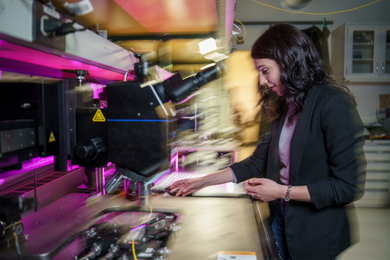This year's 2.007 contest, "Tiltillator," was a win-win-win-win situation for the top four competitors in MIT's 31st annual celebration of design, manufacturing, physics and fun.
Named in honor of its 10-foot-long seesaw table, Tiltillator required students in 2.007 (Introduction to Design and Manufacturing) to design and build machines that could either push or pull one end of the seesaw downward while an eight-pound ball swung over them from a rope attached to a central pole. The person or persons whose machine ended closest to the floor won the round.
Once the machines and the beam were in motion, Titillator pitched like a ship in The Perfect Storm.
After two nights of suspenseful competition, William S. Delhagen and Alexander T. Jacobs, both sophomores in mechanical engineering, shared the coveted prize, a dome-and-columns clock.
An eerie silence filled Johnson Athletics Center as the aluminum beam stood becalmed, flat as a tabletop, a machine hoisting up each end. Applause resounded when the 45-second round was over and fans recognized the tie for first place.
But the winners' joy was not all innocence and wonder. Knowing they would vie for first place, Mr. Delhagen and Mr. Jacobs redesigned their car-jack-type machines to perform identically in the contest's final moments.
Alexander H. Slocum, a MacVicar Faculty Fellow, professor of mechnical engineering and emcee of the popular event, harbored misgivings about the Delhagen-Jacobs plan when the pair presented it to him. After all, the rules for 2.007 required one machine to come out on top.
But Professor Slocum isn't the type to stand on ceremony when it comes to creative engineering. He dubbed the final round "The Battle of the Piston Titans" and their double win a "great engineering solution and a big surprise. Statistically, no one will win the contest so everyone should relax and have fun and help each other. Then, working together, everyone wins."
Tiltillator is the second 2.007 contest to end with a double win. Karl T. Ulrich and Richard P. White shared first place in 1979 in a contest called "A Couple Moments of Truth." It, too, employed a beam instead of a planar playing field.
Tiltillator was a 2.007 breakthrough, though: there were two pairs of double winners. William Lark, a sophomore in mechanical engineering, and Bryan Schmid, a sophomore in mechanical engineering, produced the same becalmed beam in Tiltillator as the first-place winners did. Mr. Lark built a beam-extending device that cast a rover onto the rug like a fisherman casts a lure. Mr. Schmid relied on a telescoping extension and immense torque.
Professor Slocum himself was also a winner. Named Massachusetts Professor of the Year in November 2000, he received a robust cheer performed by the MIT cheerleaders carrying pompons and leading the crowd in chanting, "Give me an A - L - E - X!"
Nam P. Suh, the Ralph and Eloise F. Cross Professor of Mechanical Engineering and head of the department, presented the teaching award to Professor Slocum.
"I didn't get this teaching award. The students got it. They are the future. You'll never have to worry about your retirement funds!" Professor Slocum declared.
Acknowledging the corporate sponsors of 2.007 (companies donate most of the hundreds of parts comprising the famed kit), he added, "This year, the students get to keep their machines. That means ownership. Ownership means passion. With passion you can accomplish anything."
PASSION, SI; TV, NO
Dressed in his signature Panama hat, Dilbert tie, measuring-tape suspenders and sneakers, Professor Slocum gave the near-capacity crowd a taste of his award-winning teaching style. As in other years, he commented gleefully on each machine's strengths or potential as he bounded between the two Tiltillator tables.
Of Kateri Garcia's astonishing climber, he declared, "In seven years of this contest I have never seen a machine take that 45-degree angle!"
The Tiltillator table inspired a repetoire of design and competition strategies. Professor Slocum named the ones that relied on winch-and-pulley systems "winchificators" or "wincher-holder-downer-thingy-boppers." Some machines dropped devices that seemed to staple themselves to the carpet ("carpet-grabbers" or "carpet-bots" or "tongs of grippage").
A popular and risky strategy was to slide towards the opponent in hopes of pushing it off, then turn back to weigh down the correct end of the beam to win the round. Professor Slocum characterized this as the "help your opponent off the table" or "drive over and push-em-up-ulator."
Some rounds required a placebo machine -- a lead brick accompanied by an inflatable plastic version of The Scream, the portrait of gasping horror painted by Edvard Munch.
While Tiltillator's quadruple-win ending portrayed cooperation and good will, Professor Slocum acknowledged the fierce competitiveness of the 2.007 contest. After all, many machines were designed to thwart their opponents by strategies just like Mr. Delhagen's and Mr. Jacobs' victorious hoist-and-strand approach.
Citing the "Naked Phone Booth Safety Rule," he said, "No one is allowed to create a 2.007 machine unless you are willing to operate it standing naked with you in a phone booth." Speaking of belly buttons, he frequently invoked the spirit of teen queen Britney Spears and her hit song, "Oops! I Did It Again." Titillator also inspired him to burst into spontaneous rhyme, as in "Can the carpet-bot/Come over and cause/Unhappiness or not?"
As in previous years, Professor Slocum shared moments from his own life, including introducing his wife and children, joking that he himself was a "study break" for his parents, and noting his delight in snowboarding, wrestling and "enhancing the geek factor."
Professor Slocum emphasized the TV-free zone he enjoyed as a child and has passed on to his own children. "My mother worked in a factory, soldering TV sets. She grew to hate TVs so much that we didn't have one. I just played with LEGOs," he said.
"Let's hear it for kids who like to build stuff! To use their brains and make stuff!" Professor Slocum shouted.
A version of this article appeared in MIT Tech Talk on May 16, 2001.








